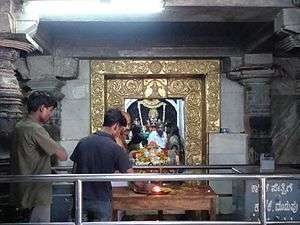Mylara Lingeshwara Temple at Mylara
| Mylara ಮೈಲಾರ Mailara | |
|---|---|
| Village | |
 Mylara Location in Karnataka, India | |
| Coordinates: 14°48′29″N 75°41′27″E / 14.80806°N 75.69083°ECoordinates: 14°48′29″N 75°41′27″E / 14.80806°N 75.69083°E | |
| Country |
|
| State | Karnataka |
| District | Bellary |
| Taluk | Hoovina Hadagali |
| Lok Sabha Constituency | Bellary |
| Languages | |
| • Official | Kannada |
| Time zone | IST (UTC+5:30) |
| Nearest city | Ranebennur |
Mylara Lingeshwara Temple (ಮೈಲಾರ ಲಿಂಗೇಶ್ವರ ದೇವಸ್ಥಾನ, ಮೈಲಾರ) is a Hindu temple dedicated to the god Khandoba (Mailari), a form of the god Shiva in Mylara. It is in the extreme south-western corner of Hoovina Hadagali taluk, Bellary District, Karnataka, India. It is 2 km from Tungabhadra river and 40 km from Hadagali and 34 km from Ranebennur.


According to legend
Mallasura[1] (demon) and his brother performed a severe penance extracted from Brahma and, with a promise that they should never be harmed by any human being, began to harass the sages or rishis. The sages appealed Shiva to protect them; Shiva took on a new form[2] and, taking with him his forces of seven crores goravas, warred with Mallasura and his brother Manikasura for 10 days> He then slew them both with his bow. During the battle, Lord Veerabhadra, Shiva's aide, struck the earth with his long hair and Kanchaveeras emerged from the spot. The Kanchaveeras confronted Mallasura and Manikasura and handed them over to Mailara. After killing Mallasura and Manikasura, Mailara (Shiva) wore their intestines as his turban, their teeth as a cowrie necklace, their mouths as a damaruga (hand drum), skulls as a doni (meal bowl) and their skins as a long coat. The fat of the demons was used as oil and their nerves athe lamp wick.
Karnika Utsava (prophecy)
Rituals during the Mailara Jatre (fair) include the Karanika Utsava (bow-climbing and prophecy-uttering ritual) and Pavada (body piercing ritual). Karanika Utsava is performed by the Karanika Gorava, who fasts for 12 days, after which he climbs a 12-meter bow and utters a euphoric prophecy regarding regional agriculture, animal husbandry, and politics.
Karnikotsava Gorava's utterance tumbida koda mooru bhaga aadeethale parakh! means "A full pot may get split into three parts". Karnikotsava means the prophecy; it is like a puzzle. Some guess it to be an indication of political situation in the state and some guess about rain and crop that means it is an indication of some threat to the agriculture so, the prophecy warns the farmers to be very careful.[3] It is believed that the saying would indicate the future of the coming year.


On Karnikotsava day, the devotees converge to the temple chanting "elukoti elukoti elukotigo... changmalo changmalo". "Elukoti" means seven crores commemorating the seven crore Goravas who accompanied Mailari. By afternoon, a huge wooden bow, symbolic of that with which Shiva slew Mallasura, is brought and placed in the middle of a vast area called Denkana maradi. The gorava carries the bow from his tent and climbs up it, stares from the top in the four directions, and then begins trembling as a sign of divine inspiration, and the pilgrims wait for his prophecy. Gorava gazes skywards, before pronouncing the annual divination. Soon after this he drops down himself from the bow, and the devotees waiting around carefully catch him. The prophecy is believed to be divine truth by the devotees.please call any more in mylara
27 February 2013- Karnika(prophecy) -ಮಳೆ ಬೆಳೆ ತಮಪಾದಿತಲೇ ಪರಾಕ್-malebele Sampaaditale paraak. 16 February 2014- Karnika(prophecy) -tumbida koda muru tunda aaditale paraak. 5 February 2015- Karnika(prophecy) -muttina gantu muru bhaga aaditale paraak.
Management
Management of the Mylar temple is done by The Wodeyar family. Earlier it was Jayachandra Wodeyar who managed the temple; now it is Sri Sri Sri Venkappayya Wodeyar on inheritance and Wodeyar family belongs to the Kshatriya cult. These people are called Guru or Swamy. They are responsible for continuing the pooja, traditions which were carried from past generation. Their temple priest is virupaksh bhat and his son pramod bhat, they are doing the dailly pooja and abhisheka and all other poojas for more details contact pramod bhat 9880640257
Goravara kunita

The gorava dance (goravara kunita), a dance of the Shiva cult, is popular in areas of North Karnataka. The goravas[4] worship Mylara linga (Shiva), wear the costume of a black woolen rug, on shoulder hanging bag made out of skin. Some of them wear a black coat and white dhoti. In traditional contexts, the gorava devotees who dance in trance sometimes bark like dogs. It is believed that the totem of the Mylaralinga is a dog. The dancers' feet move in clockwise and zigzag forms. Gorava wears yellow powder on his forehead and gives it to his believed devotees. Artists holds instruments, like damaru (percussion), or sometime holds kolalu (flute), and a few artists wear a small bronze bell on their shoulders. A few followers hold cowbells called paarigante.
Gallery
References
| Wikimedia Commons has media related to Mylara Lingeshwara Temple. |
- ↑ "Epic Narrative as a Blurred Genre". Retrieved 2008-10-29.
- ↑ By M.N. Venkatesha "Mailaralinga by M.N. Venkatesha" Check
|url= - ↑ "Thus spake Mylara". The Hindu (Chennai, India). 2008-02-29. Retrieved 2008-10-29.
- ↑ "Professional Religious Singers, Gorava". Retrieved 2008-10-29.
| ||||||





